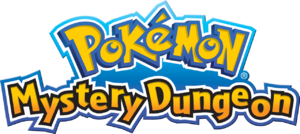Pokémon Mystery Dungeon series: Difference between revisions
(YOUR PAGE IS MINE) |
m (→Gameplay) |
||
| Line 14: | Line 14: | ||
==Gameplay== | ==Gameplay== | ||
Pokémon Mystery Dungeon is an adaptation of the {{wp| | Pokémon Mystery Dungeon is an adaptation of the {{wp|Mystery Dungeon}} games. Like the main Pokémon RPGs, it has two gameplay modes; unlike the [[Version|main RPG]]s, battle mode and dungeon mode are not distinct. It is a turn-based game, with each step, attack, or item use being counted as a single turn. | ||
The size of a [[party]] is limited to four in Pokémon Mystery Dungeon, compared to six in the main RPGs. Furthermore, players are only able to directly control one Pokémon: their own character (or, later in the game, any other befriended Pokémon). The player's teammates are essentially autonomous, with player control being limited to general strategy such as avoiding Pokémon battles or not moving and staying in one place. The type of AI used by team members can be changed. | The size of a [[party]] is limited to four in Pokémon Mystery Dungeon, compared to six in the main RPGs. Furthermore, players are only able to directly control one Pokémon: their own character (or, later in the game, any other befriended Pokémon). The player's teammates are essentially autonomous, with player control being limited to general strategy such as avoiding Pokémon battles or not moving and staying in one place. The type of AI used by team members can be changed. | ||
Revision as of 03:15, 11 September 2013
The Pokémon Mystery Dungeon series is a series of games, currently comprised of nine different games. The series of games have been expanded into several mangas and several anime specials.
History
The first pair of games in the series, Pokémon Mystery Dungeon: Red Rescue Team and Blue Rescue Team, were released on the Game Boy Advance and the Nintendo DS in 2005 and 2006. An anime special loosely based of the game, Pokémon Mystery Dungeon: Team Go-Getters Out of the Gate!, first aired in Japan on March 23, 2007 and in the United States on September 8, 2006.
The second pair, Pokémon Mystery Dungeon: Explorers of Time and Explorers of Darkness, were released on the Nintendo DS in 2007 and 2008. Another anime special, Pokémon Mystery Dungeon: Explorers of Time & Darkness, first aired in Japan on September 9, 2007. It aired almost a year later in the United States on September 1, 2008.
Their third version, Pokémon Mystery Dungeon: Explorers of Sky, were released in 2009, with several additions to the storyline of Time and Darkness. The most recent anime special, Pokémon Mystery Dungeon: Explorers of Sky - Beyond Time & Darkness, aired in Japan on April 12, 2009, airing in the US a few months later, on October 9, 2009.
In August 2009, Pokémon Mystery Dungeon: Keep Going! Blazing Adventure Squad!, Pokémon Mystery Dungeon: Let's Go! Stormy Adventure Squad!, and Pokémon Mystery Dungeon: Go For It! Light Adventure Squad! were released on WiiWare, on the Wii. Each game is slightly different from each other, with less story and background than other Mystery Dungeon games.
The most recent addition, Pokémon Mystery Dungeon: Gates to Infinity, was released in Japan on November 23, 2013 for the Nintendo 3DS.
Gameplay
Pokémon Mystery Dungeon is an adaptation of the Mystery Dungeon games. Like the main Pokémon RPGs, it has two gameplay modes; unlike the main RPGs, battle mode and dungeon mode are not distinct. It is a turn-based game, with each step, attack, or item use being counted as a single turn.
The size of a party is limited to four in Pokémon Mystery Dungeon, compared to six in the main RPGs. Furthermore, players are only able to directly control one Pokémon: their own character (or, later in the game, any other befriended Pokémon). The player's teammates are essentially autonomous, with player control being limited to general strategy such as avoiding Pokémon battles or not moving and staying in one place. The type of AI used by team members can be changed.
Most of the gameplay takes place within mystery dungeons, with many floors and hostile Pokémon. Due to the many dangers, exploration teams prepare for the challenges by using the many services offered at Pokémon settlements such as Pokémon Square and Treasure Town.

|
This article is part of Project Sidegames, a Bulbapedia project that aims to write comprehensive articles on the Pokémon Sidegames. |
